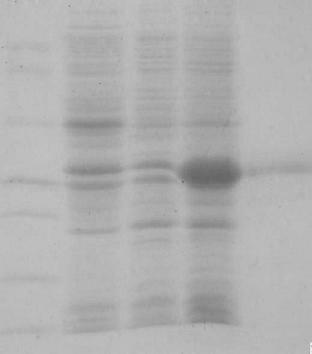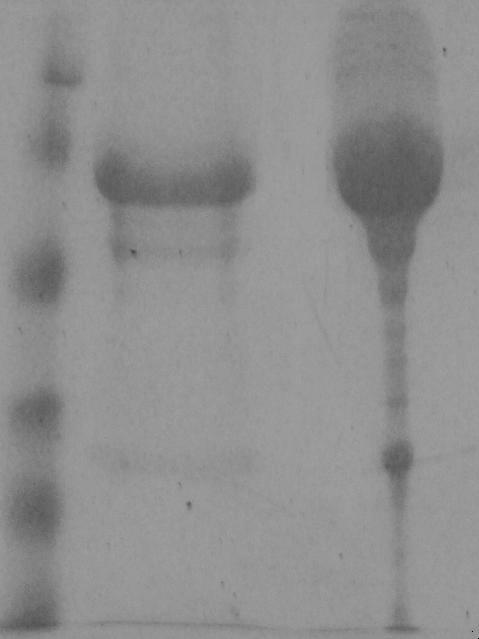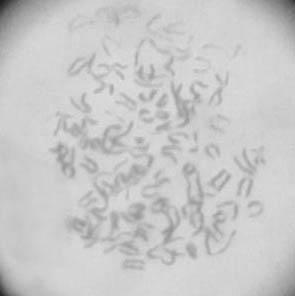Activated toxic antibody kit for detecting porcine reproductive and respiratory syndrome virus
A technology for respiratory syndrome and pig breeding, which is applied in the fields of new animal disease diagnostic reagents, live virus antibody kits, and liquid-phase blocking ELISA preparation to achieve low production costs, strong specificity, and improved sensitivity and specificity Effect
- Summary
- Abstract
- Description
- Claims
- Application Information
AI Technical Summary
Problems solved by technology
Method used
Image
Examples
Embodiment 1
[0041] Example 1 Preparation and Purification of Porcine Reproductive and Respiratory Syndrome Virus Nsp9 Protein
[0042] The identified positive recombinant plasmid pET-28a-Nsp9 was transformed into BL21(DE3) competent cells, and the bacteria were picked on the plate (Kan100 mg / mL), and the positive bacteria were coated with kanamycin (100 mg / mL) in LB liquid medium (Kan 100 mg / mL) overnight, then inoculated at 1% in LB medium (Kan 100 mg / mL) containing kanamycin, and cultured at 37°C until the logarithmic growth phase (OD600nm= 0.6), add IPTG (final concentration 1mmol / L), and induce culture at 37°C for 3 h. Centrifuge and precipitate the bacteria, and after ultrasonic crushing, obtain high-purity recombinant protein by electroelution, and store it at -80°C for future use. For identification results, see figure 1 .
Embodiment 2
[0043] Example 2 Preparation of Anti-Porcine Reproductive and Respiratory Syndrome Virus Nsp9 Protein Monoclonal Antibody
[0044] 1. For animal immunization, select healthy Balb / C mice aged 6-8 weeks to emulsify the purified PRRSV Nsp9 protein with complete Freund's adjuvant, and inject about 100 μg intraperitoneally into each mouse, and emulsify the protein intraperitoneally with incomplete Freund's adjuvant 14 days later. 100μg was injected, and at the last booster immunization, 100μg purified protein was directly injected intraperitoneally, and 50μg purified protein was injected into tail vein 3-4 days before fusion.
[0045] 2. Cell fusion Take splenocytes from immunized mice and mix them with SP2 / 0 in a fusion tube, centrifuge at 300g for 10 min, discard the supernatant, shake the cells to mix the two cells as evenly as possible, and then slowly drop and preheat within 60 seconds PEG-4000 solution, then slowly add serum-free 1640 medium to terminate the fusion, let it ...
Embodiment 3
[0054] Example 3 Establishment of blocking ELISA method
[0055] 1. The establishment of the reaction program
[0056] (1) Procedure of indirect ELISA method:
[0057] Coating: Dilute the ELISA antigen diluted with pH9.6 carbonic acid buffer to 0.2 μg / well, add 100 μL per well to the microtiter plate, and leave overnight at 4°C. Dry the coating solution and wash the plate 3 times with PBST (PBS containing 0.05% Tween-20, pH7.2). Blocking: Add 5% skimmed milk blocking solution, 300 μL / well, 37°C for 60 minutes, spin dry, wash with washing solution 3 times, 300 μL / well, 3 minutes each time. Adding samples: add anti-PRRSV Nsp9 protein monoclonal antibody 2D6, 100 μL per well, and react at 37°C for 60 min; wash with washing solution 5 times, 300 μL / well, 3 min / time. Add HRP-labeled goat anti-mouse HRP enzyme-labeled secondary antibody, 100 μL per well, and react at 37°C for 45 min; shake off the liquid, wash the plate, add TMB, 100 μL per well, and react at room temperature ...
PUM
 Login to View More
Login to View More Abstract
Description
Claims
Application Information
 Login to View More
Login to View More - R&D
- Intellectual Property
- Life Sciences
- Materials
- Tech Scout
- Unparalleled Data Quality
- Higher Quality Content
- 60% Fewer Hallucinations
Browse by: Latest US Patents, China's latest patents, Technical Efficacy Thesaurus, Application Domain, Technology Topic, Popular Technical Reports.
© 2025 PatSnap. All rights reserved.Legal|Privacy policy|Modern Slavery Act Transparency Statement|Sitemap|About US| Contact US: help@patsnap.com



